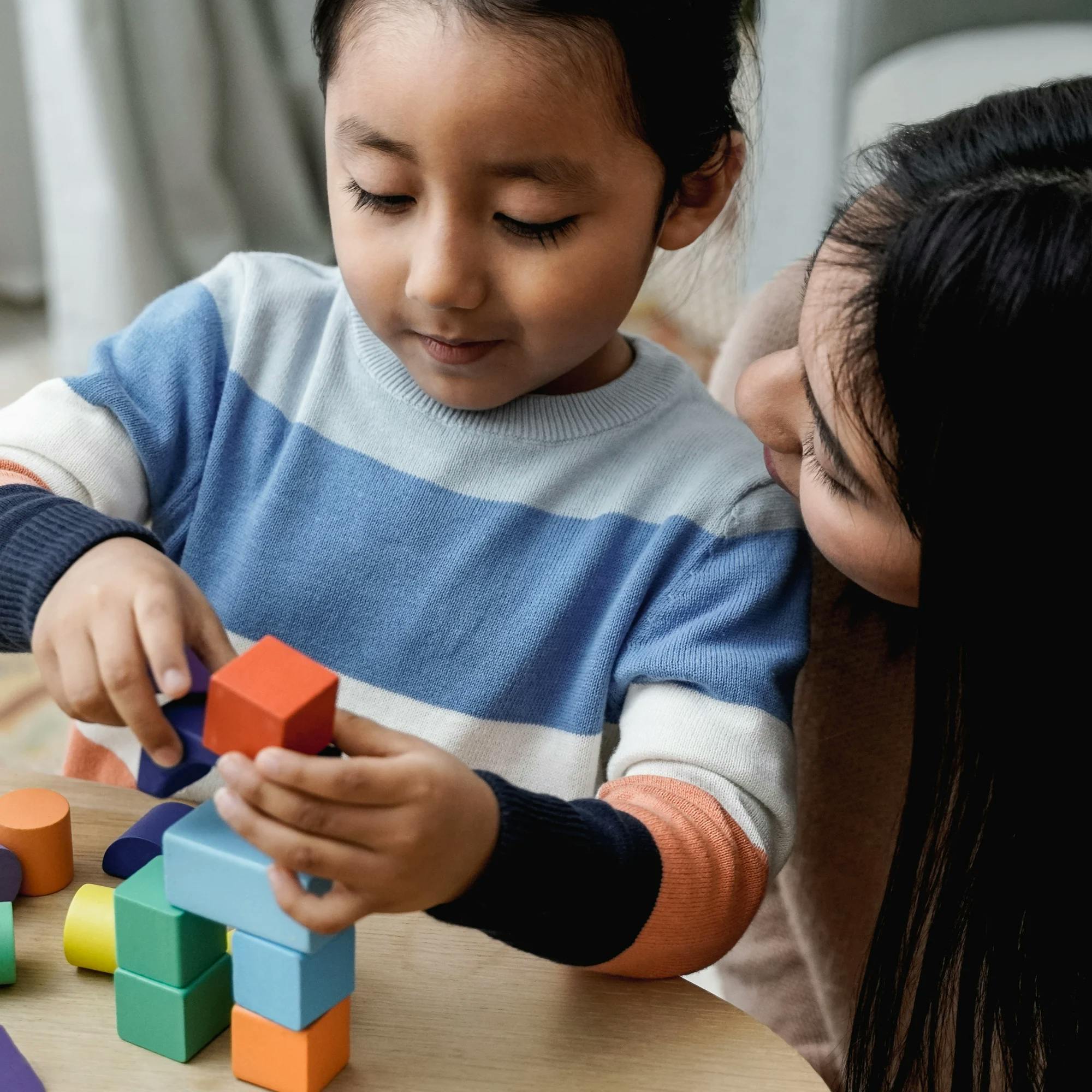While every autistic child is unique, many have language that develops differently than we expect. Some kids may be completely nonspeaking (which some people refer to as being "nonverbal”). Some may communicate in other ways, such as the use of gestures, pictures, or a device. Others may communicate verbally but need support to develop more complex language, like in sentences and conversation.
According to the CDC, the most common developmental therapy for autistic people is speech therapy. Speech therapy helps to improve people’s understanding and use of speech and language. One reason speech therapy is so valuable for autism is because it isn’t one-size-fits-all. A speech therapist creates personalized goals and treatment activities to support each child's communication.
Let’s take a deeper look at how speech therapy helps support children with autism and what sessions might look like. For details about Expressable's clinical approach to working with autistic people, check out our autism treatment guide.
Personalized care for your child
We support autistic children for who they are and help them build new skills. Get matched with a licensed speech therapist today.
 Get started
Get startedWhat does a speech therapist do?
If you’re just beginning to research speech therapy, you may be wondering what a speech therapist actually does. That’s a valid question!
A speech-language pathologist, also known as a speech therapist, helps people of all ages improve their communication abilities. Speech therapists work to prevent, evaluate, diagnose, and treat a range of issues affecting speech, language, social communication, cognitive communication, voice, feeding and swallowing, and more. Just like a physical therapist helps a person gain physical function and independence, a speech therapist does this in the area of speech and language.
Speech therapists complete a master’s program, which includes extensive clinical internship placements, followed by certification exams. They are also licensed at the state and national level.


How does speech therapy work?
Speech therapy starts with an initial evaluation. This helps the speech therapist identify the person’s current strengths and where they need support. The speech therapist takes the findings from the evaluation and creates individualized goals for that person. Therapy sessions will then focus on building the skills needed to achieve each of these goals.
Parents and caregivers are a big part of the goal-building process. Your speech therapist will ask you about your specific concerns or goals for your child and find a way to address them in therapy.
Parents and caregivers are a big part of the goal-building process.
As an example, let’s say your child is nonspeaking and you have a hard time understanding what they want. Your speech therapist may work on teaching your child to point, gesture, or use pictures to communicate. This gives them a form of functional communication and helps relieve frustration for both your child and you.
Can autistic children receive online speech therapy?
If you’re considering online speech therapy for your autistic child, you may be wondering if it will be a good fit for them. What if your child isn’t comfortable sitting in front of a screen?
Every online speech therapist will assess whether online sessions are right for their client. But the good news is that for many autistic children, it’s an excellent fit. Even if families have reservations initially, many soon begin saying, “I’m so glad we tried it!"
Several systematic reviews, which pull together findings from research studies, support this. These reviews have found that for autistic individuals and their families, online speech therapy is just as effective as in-person therapy. In some cases, teletherapy works even better than in-person services. Here are some of the reviews:
Ogourtsova et al. (2023) found that teletherapy interventions for autistic children and youth were often more effective than in-person approaches. Teletherapy was never found to be less effective than in-person intervention.
Ellison et al. (2021) found that across 55 telehealth studies, the majority had outcomes equal to in-person services.
Sutherland et al. (2018) found that across 14 studies, speech-language services delivered by telehealth were equivalent to services delivered face-to-face.
de Nocker and Toolan (2023) found that telepractice interventions work as well as in-person interventions when it comes to language and social communication.
Akemoglu et al. (2020) found that all studies reported measurable improvements in children’s communication skills and/or parents’ use of strategies to support their children’s communication.


How does online speech therapy work for autistic children?
Speech therapists have a variety of ways to help kids participate during online sessions, even if they won’t pay attention to a screen. In fact, online speech therapy is much more than just sitting in front of a laptop or tablet.
One of the biggest benefits of online speech therapy is the ability for parents and caregivers to be part of sessions. Studies show that parent involvement greatly affects how quickly a child makes progress. In fact, research has shown this specifically for parents of autistic children. If the child is having a hard time directly interacting with the speech therapist, the therapist will use parent coaching to show caregivers how to use the communication techniques with their child. That way, families know how to practice with their child throughout the week, and the learning isn’t limited to therapy sessions.
One of the biggest benefits of online speech therapy is that caregivers can be part of sessions. This greatly affects how quickly a child makes progress.
Speech therapy sessions should be child-led, or tailored to your child’s interests and learning style. The speech therapist will use motivating play activities to help foster as much participation as possible. This could be anything from reading a book together, to playing with your child's favorite toy cars, to physical movement and games. Therapists are experienced in “going with the flow” during sessions. They can find a way to work on speech goals in pretty much any situation. Check out our article "What if My Child Won't Sit in Front of a Screen for Speech Therapy?" for more examples of how this works.
How often do autistic children need speech therapy?
You may wonder how many hours of speech therapy your child needs, or how long speech therapy for autism will last. As mentioned above, every child is unique, and there are many factors that affect how long speech therapy will take. For many children, the more often they can attend sessions, the better their outcomes will be.
But again, one of the biggest factors in their success is how often their caregiver uses the same strategies learned in speech therapy at home, during everyday life. In other words, it’s less about how often your child has speech therapy and more about how often you’re practicing these new skills and supports outside of sessions!
Let’s look at a few common techniques and strategies that speech therapists use to support children with autism.


Speech therapy technique for autism: Gesturing
As mentioned in our earlier example, children who aren’t yet talking need some form of communication to help them express themselves. Every person needs the ability to communicate. Can you imagine not being able to tell someone that you’re hungry, need help, or are in pain? Gesturing is an effective way for some nonspeaking children to get across some of their thoughts.
Independent pointing can be helpful for the child’s communication partner. A speech therapist may work with a child on pointing to their desired object, such as a toy or a snack. Gesturing in response to questions such as “What do you want to eat?” or “Where does it hurt?” is also extremely beneficial. Some children, instead of pointing, prefer to lead the adult’s hand to the object they’re requesting.
Just because a child isn’t talking doesn’t mean they don’t understand what’s said to them.
An important note: Just because a child isn’t talking doesn’t mean they don’t understand what’s said to them. There are two types of language. The ability to communicate thoughts and needs verbally or nonverbally is called expressive language, and the ability to understand what is spoken is called receptive language.
During your child’s initial speech therapy evaluation, both of these areas will be assessed. The speech therapist will use the child’s receptive language abilities to their advantage, asking questions in a way that can help communication partners get as much information from the child as possible.


Speech therapy technique for autism: Augmentative and alternative communication (AAC)
Augmentative and alternative communication (AAC) can be used by those who are nonspeaking, are minimally speaking, or simply feel more comfortable using a device to help them communicate. Research also shows that using AAC can support development of spoken language! AAC can be used short or long term, depending on the person’s needs.


Any method that can help a person communicate counts as AAC. There are many types of AAC, and they’re usually divided into two categories: high-tech and low-tech/no-tech.
No-tech/low-tech AAC includes using communication systems such as:
Writing
Drawing
Pointing to pictures/written words
High-tech AAC includes digital technologies, such as:
Apps on an iPad or other tablet
Computers with text-to-speech software
Devices with pre-recorded messages
Speech-generating devices, which are a computer or an app with a voice
Speech therapists help children learn to use their AAC system and teach their families how to use it, as well. Getting used to an AAC device can take some time, but AAC opens a whole new world of communication possibilities!


Speech therapy technique for autism: Supporting verbal communication
For children who are already speaking or just beginning to talk, speech therapy can help them:
Increase the number of words they can say
Speak in longer phrases and sentences
Learn grammar skills
As always, the speech therapist will find activities that the child enjoys in order to target new skills. Let’s say a child is working on requesting items with complete sentences. The speech therapist will use toys or games that the child is interested in asking for. The speech therapist will either model the words, or give the child clues to help them complete or form the sentence themselves.


How to find a speech therapist for your autistic child
If you’re considering speech therapy for your child, don’t wait to begin the hunt for the right speech therapist. You can start by speaking with your pediatrician and checking with friends and family who may have first-hand recommendations.
When searching online, be sure to read the reviews! There are several online directories where you can search speech therapists by location and qualifications. One of these directories is compiled by the American Speech-Language-Hearing Association (ASHA), which is the professional credentialing organization for speech-language pathologists.
Keep in mind, your child may need some time to adjust to speech therapy. After all, they’re transitioning to a new experience and getting to know a new person. If you receive any pushback or hesitancy from your child, that’s normal! Give it several sessions for your child to warm up to this new routine. Once they form a connection with their speech therapist, that’s when the learning and growth really happens.
An important note: We believe that when speaking about any community as a whole, the best approach is to prioritize that community’s voices, needs, and preferences. Within the larger autism community, the current language preference is identity-first (e.g., autistic child), which is why we use that language in our content. Expressable is committed to listening to and learning from the populations we serve. If and when their preferences change, we’ll adjust our approach accordingly.
How Expressable Can Help
Concerned your child isn't reaching age-expected milestones? Looking for communication support from a professional? Expressable is a national online speech therapy practice serving children and adults. We treat all major areas of communication and feeding, offer flexible hours including evenings and weekends, and accept most major health insurance plans. We’re proud to have earned more than 3,000 5-star reviews from our clients (4.9/5 average).
Our therapy model is centered on parent and caregiver involvement. Research proves that empowering caregivers to participate in their loved one’s therapy leads to better outcomes. That’s why we combine live, 1-on-1 speech therapy with personalized education and home practice activities for faster progress.
Communication is more than words. It’s how we share how we feel and show who we are. We’re here to help you or your child do just that.
 Abby Barnes, M.S., CCC-SLP
Abby Barnes, M.S., CCC-SLP












